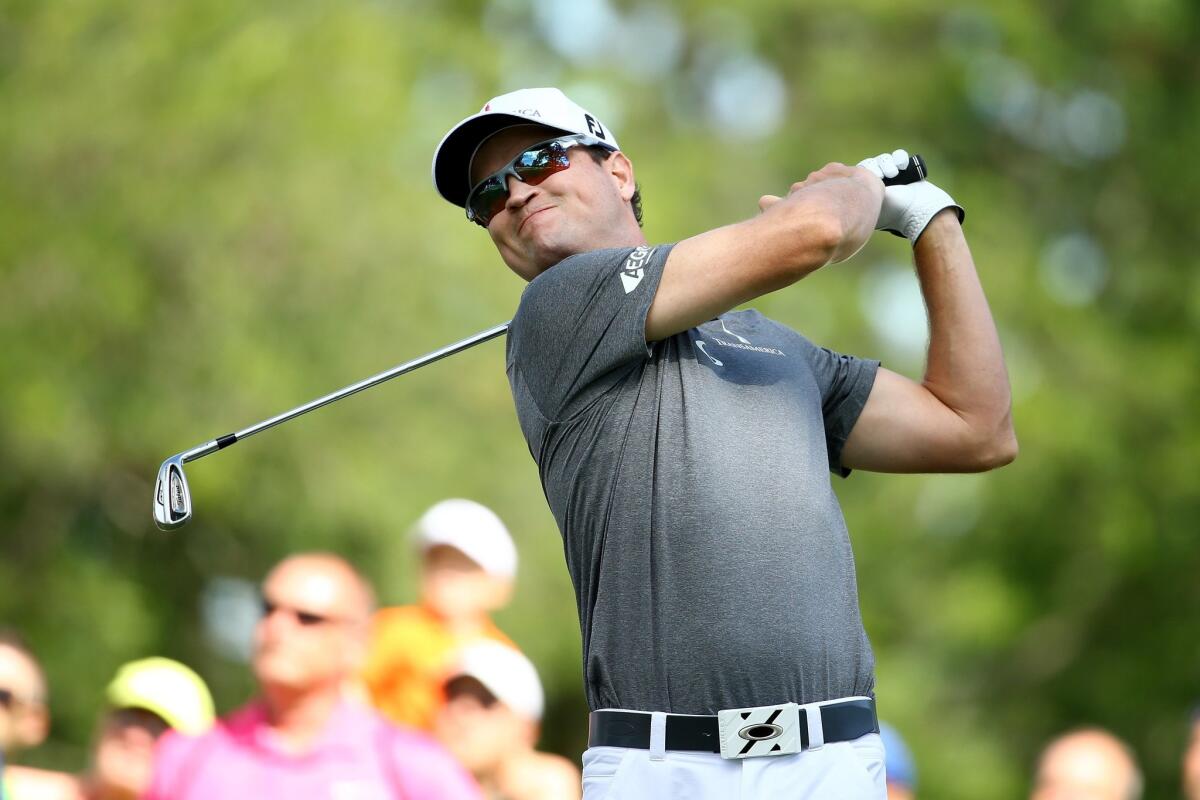Short and steady off the tees could win the day at Whistling Straits

Former Masters champion and recent British Open winner Zach Johnson is considered among the straight hitters with a chance to win the PGA Championship at Whistling Straits.
- Share via
The man who brought two U.S. Open titles to his native Wisconsin stood at the Whistling Straits practice range Tuesday, observing the modern representative of Wisconsin golf.
Andy North watched as Madison-area native and resident Steve Stricker honed his swing for this week’s PGA Championship.
Asked if Stricker, the patron saint of short hitters, could win on this 7,501-yard course, North replied: “Absolutely. Look at the last three major champions. They’re all average, at best, in length.”
Indeed, Jordan Spieth and Zach Johnson showed that power is only one component to winning golf.
“Accuracy is more important,” Johnson said.
No doubt that’s true, but some of the numbers produced last weekend at the Bridgestone Invitational were simply astounding.
Bubba Watson smashed a 399-yard drive Sunday on the eighth hole at Firestone that was merely the fourth-longest of the week. The 16th hole Sunday yielded the longest bombs of the PGA Tour season -- 428 yards by Bernd Wiesberger and 410 by Marc Leishman. Dustin Johnson smashed a 406-yarder Friday on the 16th.
“The numbers at Bridgestone are skewed because the fairways are mowed so tight, they’re like greens,” said North, now an ESPN analyst. “If you can carry it over the ridges in the fairways, the ball would hit the downslope and roll out another 80 to 100 yards.”
Watson agreed that “everything set up for hitting the ball farther,” and he took full advantage. Five of his Sunday drives went at least 358 yards.
Asked if shorter hitters ever ask him for advice, Watson replied: “No, because they look at my accuracy statistics. I’m asking them how to hit fairways. They don’t want to be wild like me.”
Jim Furyk is comfortable calling himself a “short hitter,” as he did last week during the Bridgestone. And the numbers bear that out: He ranks 178th on tour with an average drive of 276.8.
“I’ve had a couple of years where I’ve chased distance,” he said, “and I’ve looked for products that went farther. A titanium driver came out in the mid-’90s, and we instantly gained 10 yards. And solid golf balls, we gained a bunch of yards.
“But now, if you’re chasing distance, you’re giving up in other parts of your game. I’ve realized that I don’t hit it that far, but I hit it far enough.”
Furyk, who hits 71.7% of fairways, good for ninth on tour, switched drivers last week. He put a 9-degree Callaway Great Big Bertha with neutral directional bias in his bag.
“I always have products where I can really spin the ball,” he said. “In doing so, I can take advantage of my strengths -- hitting the ball pretty straight, and from 120 yards in, control the flight and stop shots.”
Pat Goss, the Northwestern golf coach who walked the course Tuesday with pupil Luke Donald, said equipment -- the driver and ball -- is the main reason so many players are “ridiculously long.”
Donald has not made major gains, though, and Goss acknowledged of the former world No. 1: “It is difficult to keep Luke focused on his strengths as he plays with players who hit it by him and have shorter clubs in. However, history has shown there is always a place for players who can control their balls, control their distance and are great putters.”
Look at Zach Johnson, who won the British Open last month. He also tamed Whistling Straits in 2010, finishing one shot out of the Watson-Martin Kaymer playoff.
“I think I proved (length) doesn’t matter,” Johnson said. “But the ball was rolling in 2010. And I can always use more roll.”
In his prime, North was a bit longer than average on the PGA Tour, hitting most of his drives in the range of 263 to 267 yards. He’s 65 now and 20 yards longer off the tee.
“That makes a lot of sense, right?” he said. “They talk about these guys being better athletes. It’s a bunch of baloney. Jack Nicklaus would have hit these clubs and this ball 400 yards.
“And it’s not just an old guy talking. There have been good athletes playing for a long time. There may be more now, but it’s the equipment and maintenance of the courses that has changed so dramatically.”
More to Read
Go beyond the scoreboard
Get the latest on L.A.'s teams in the daily Sports Report newsletter.
You may occasionally receive promotional content from the Los Angeles Times.










